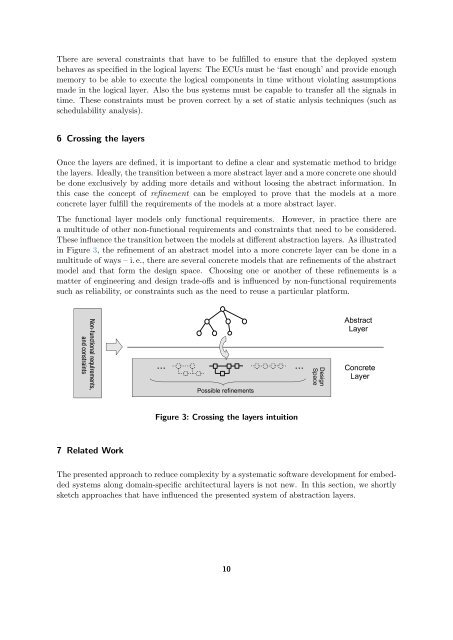SPES 2020 Deliverable D1.2.A-1 Abstraction Layers
SPES 2020 Deliverable D1.2.A-1 Abstraction Layers
SPES 2020 Deliverable D1.2.A-1 Abstraction Layers
Create successful ePaper yourself
Turn your PDF publications into a flip-book with our unique Google optimized e-Paper software.
There are several constraints that have to be fulfilled to ensure that the deployed system<br />
behaves as specified in the logical layers: The ECUs must be ‘fast enough’ and provide enough<br />
memory to be able to execute the logical components in time without violating assumptions<br />
made in the logical layer. Also the bus systems must be capable to transfer all the signals in<br />
time. These constraints must be proven correct by a set of static anlysis techniques (such as<br />
schedulability analysis).<br />
6 Crossing the layers<br />
Once the layers are defined, it is important to define a clear and systematic method to bridge<br />
the layers. Ideally, the transition between a more abstract layer and a more concrete one should<br />
be done exclusively by adding more details and without loosing the abstract information. In<br />
this case the concept of refinement can be employed to prove that the models at a more<br />
concrete layer fulfill the requirements of the models at a more abstract layer.<br />
The functional layer models only functional requirements. However, in practice there are<br />
a multitude of other non-functional requirements and constraints that need to be considered.<br />
These influence the transition between the models at different abstraction layers. As illustrated<br />
in Figure 3, the refinement of an abstract model into a more concrete layer can be done in a<br />
multitude of ways – i. e., there are several concrete models that are refinements of the abstract<br />
model and that form the design space. Choosing one or another of these refinements is a<br />
matter of engineering and design trade-offs and is influenced by non-functional requirements<br />
such as reliability, or constraints such as the need to reuse a particular platform.<br />
Non-functional requIrements,<br />
and constraints<br />
7 Related Work<br />
... ... Design<br />
Possible refinements<br />
Figure 3: Crossing the layers intuition<br />
Space<br />
Abstract<br />
Layer<br />
Concrete<br />
Layer<br />
The presented approach to reduce complexity by a systematic software development for embedded<br />
systems along domain-specific architectural layers is not new. In this section, we shortly<br />
sketch approaches that have influenced the presented system of abstraction layers.<br />
10
















